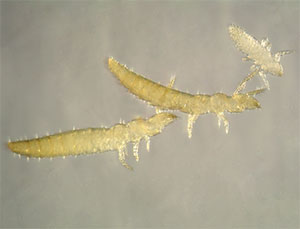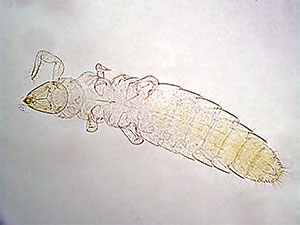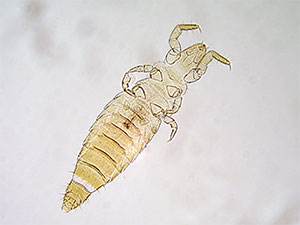|
Protura

Several of New Zealand Protura.
Common name: proturans.
Scientific name: phylum Arthropoda, class Protura — from Greek “pro”, first, and “ura”, tail.
Description
Protura are among the smallest of wingless soil arthropods — usually 0.2-2.0 mm in length. Their body is divided into a head, a thorax with three pairs of walking legs, and a segmented abdomen. The first three abdominal segments bear very small appendages (only seen under a compound microscope).
There are no eyes or antennae on the head, and the head is quite small and narrow. The first pair of legs (forelegs) has sensory function, and is typically held extended forward, which can cause the forelegs to be easily mistaken for antennae. Protura are white, but the end of the abdomen and the tips of the forelegs are often light yellow. Some adults can be darker yellow all over, due to stronger sclerotization. Protura are considered to be a sister group to Collembola, and one of the oldest groups of terrestrial arthropods.
 Eosentomon dawsoni
Eosentomon dawsoni (Protura) from native forest, Manawatu-Wanganui, New Zealand.
|  Gracilentulus gracilis
Gracilentulus gracilis (Protura) from Pinus radiata
plantation, Manawatu-Wanganui, New Zealand.
|
Notes on biology
Very little is known about the biology of
Protura — their diet, life history, interactions with
other organisms and the role in the environment remain unknown.
In culture, proturans have been observed feeding on mycorrhizal
fungi. The details of proturan reproduction are also unknown.
Development is direct, through a series of moults —
juveniles resemble adults in general appearance, except for
smaller size and fewer abdominal segments. Juvenile Protura
also have incomplete sets of body setae and undeveloped reproductive
organs.
Where to find them?
Protura can be found in the upper layers
of soil, in leaf litter and decaying wood, underneath the
bark on dead trees, in moss, and in other similar habitats.
Some have been collected from ant nests, caves, and nests
of small mammals. Although common, Protura are not routinely
encountered in soil samples. Sometimes they are present in
large numbers - population density of Protura in New Zealand
can reach from several hundred to several thousand individuals
per square meter; their distribution is very patchy.
Because of their small size and relative
rarity, observing or collecting live proturans in the field
is difficult. The most effective way to collect Protura is
by using the Berlese funnel. Collected Protura can be preserved
in 75% alcohol.
Distribution and conservation
Proturans are found world-wide in tropical
and temperate regions; they have not been recorded in Antarctica
or the Arctic. About 500 species have been described to date.
Fourteen species of Protura are known from New Zealand (Tuxen,
1985). Five of these species are found elsewhere in the Southern
hemisphere and are thought to originate from the super-continent
Gondwana. Two species appear to have been introduced to New
Zealand from Europe and nine species are endemic to New Zealand.
In New Zealand, proturans can be found in native forests,
in exotic Pinus radiata plantations, and in agricultural
soil. Protura are poorly studied, and very little is known
about New Zealand proturans, apart from species names. They
are not protected.
Included images:
- Family Acerentomidae
- Gracilentulus sp. - Wanganui, WI, North Island (2 images)
- Gracilentulus sp. - Wanganui, WI, North Island (4 images)
- Gracilentulus sp. - Wanganui, WI, North Island (3 images)
- Family Eosentomidae
- Eosentomon sp. - Wanganui, WI, North Island (2 images)
- Eosentomon sp. - Wanganui, WI, North Island (2 images)
Further information on New Zealand
Protura:
Copeland T.P., Imadate G. 1990. Insecta:
Protura. In: Dindal D.L. (ed.). Soil Biology Guide. J. Wiley
& Sons, New York, p. 911-933.
Tuxen, S.L. 1986. Protura (Insecta). Fauna
of New Zealand 9, 52 p.
Ramsay G.W., Tuxen S.L. 1978. Protura (Insecta)
from the Kermadec Islands, and a redescription of Acerentulus
nemoralis from Argentina. New Zealand Journal of Zoology
5, p. 601-606.
Wise K.A.J. 1977. A synonymic checklist
of the Hexapoda of the New Zealand sub-region. The smaller
orders. Bulletin of the Auckland Institute and Museum, No.
11, 176 p.
Protura Resources on the Web
The
Tree of Life - Protura, includes brief description and
a good source of references, including links to other Protura
sites.
Australian Faunal Directory: Checklist for Protura, a checklist of
Australian species and a list of worldwide literature on Protura.
Japanese
Protura, maintained by Osami Nakamura, includes a check-list
and a taxonomic key to species of Protura found in Japan and
Taiwan.
Nomina
Insecta Nearctica - Protura, a checklist of North American
Protura.
Protura,
CSIRO, a brief but informative description.
Gordon
Ramel's Protura page, contains some facts on biology of
proturans.
|